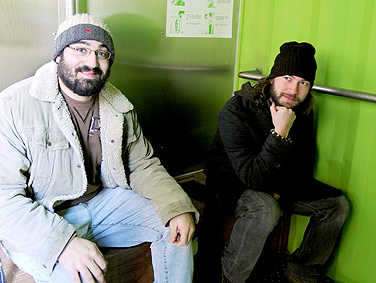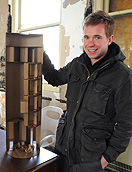News
Bathrooms offer best seat in the house

Todd Graci and Patrick Connolly in their econ-friendly bathroom, dubbed “Parasite.” Photo: NANCY J. PARISI
-
 Print
Print -
 Comments
(1)
Comments
(1)
-

Daniel Nead shows off his circular cardboard model of a cereal museum. Photo: NANCY J. PARISI
No one can say that Beth Tauke, associate professor of architecture in the School of Architecture and Planning, isn’t taking full advantage of her access to one of Buffalo’s most notable grain elevators—Marine A on Childs Street, along the Buffalo River.
The elevators of Buffalo have long been of great interest to UB architects because they comprise the most outstanding collection of extant grain elevators in the United States and collectively represent the variety of construction materials, building forms and technological innovations that revolutionized the handling of grain in this country. They have written books about them, photographed them, entertained in them, directed tours and now use them as classrooms.
During the fall 2011 semester, for instance, Tauke’s graduate studio required students to adaptively reuse Marine A’s massive space as an entertainment venue of some kind—a challenge given the size of the building and its massive open vertical spaces, composed as a horizontal series of concrete silos.
The results were reported out in November in an icy and forlorn former office building that is part of the Childs Street silo complex owned by Rick Smith, the art- and architecture-loving CEO of Rigidized Metals Corp., who attended the presentation.
Proposals ranged from designs for an outdoor film presentation space to an art gallery, a training center for deep sea divers, a concert facility, a cereal museum (because Buffalo smells like Cheerios, of course) and a digital arts exhibition area that struck fascinating mood and spatial changes with soft, constantly modulating digital lighting.
One more thing. The students, all candidates for a master’s degree in architecture, also were required to incorporate unique public bathrooms into their designs. Thus, we’re introduced to such elements as a steam curtain to effectively mask urinal users from public gaze and concert-space bathroom seating so spectacular (they really are the best seats in the house) that a 10-minute use limit would have to be imposed on users just to keep the traffic moving.
In fact, the public bathroom designs were among the most interesting elements of the proposals. Although most presentations were two-dimensional, with an occasional 3-D model, Patrick Connolly and Todd Graci built a full-size prototypical outdoor, eco-friendly, public bathroom next to Marine A that could serve three users at a time. They began with a shipping container and ended up with three spacious stalls containing compost toilets that turned neatly into baby changing stations, solar-powered lighting, a solar fan and compostable toilet paper.
Lauren Massari suggested opening two of the elevators’ towers to natural light by replacing part of the concrete construction with fenestration and employing the windowed space as a bathroom area with an unusual—and wide-open—view of the waterfront from several stories up, while retaining absolute privacy for the user.
Kevin Pereira designed an event space that employed the ground-level space between the elevator’s marine legs—those long, massive steel columns that once housed an endless chain with buckets attached that scooped grain into and from ship holds. In those spaces, he proposed a series of vertical bathroom structures that would accommodate families and users of various physical abilities and a separate block devoted to urinals. Blackened metal frames held wooden “flaps” constructed so that users can see out of the stalls, but the nosy public could not peer in.
Sarah Weishaupt developed the space in a way that incorporated colors found on the exterior of the elevator—time-generated variations in the color of the concrete itself, plus striations produced by interior steel support stains and surrounding vegetation. She proposed translucent flooring to conceal lighting in soft, related colors that would shine up 10-plus stories into the huge silos and onto the elevator ceiling “to create an active memory of the original use of the building.”
Michael Moch devised a plan that permitted visitors to “move inside the structure in the same way grain moved originally.” He proposed an elevator to bathrooms built at the top of the silos with a steam curtain between the urinals and public space, and an optional playful corkscrew slide to the ground floor.
Greg Andriano, who has since graduated and is now working his dream job for Disneyworld, presented an outdoor music venue with private spaces in public places—40 “great seats” above the stadium floor from which audience members could watch the show live while using the loo.
Andriano says concert goers are usually loathe to go to the bathroom during performances so long lines and congestion often ensue during intermission. With “special seating,” they might be willing—even eager—to go to the bathroom while the show is going on. The concert sound would be enhanced by speakers incorporated into bathroom countertops and translucent polycarbonate walls would be lit from within, ensuring privacy from the audience below.
Daniel Nead proposed a cereal museum that used grain circulation through the elevators to tell the story of how grain turns into Cheerios, Wheaties, Chex, Kix, etc. He used one grain silo to house a tower of kid-friendly restrooms.
Sampada Pulekar developed a sustainable lounge restroom area along the riverfront. Her bathrooms emulated the towering silos of Marine A, but changed the scale and proportion to fit the new program. Photovoltaics provide energy; open tile patterns allow for natural air flow and composting toilets reduce water use.
Kyle Mastalinski came up with a design for a unique diving training center, which he said, might be quite a draw, given the dearth of similar regional facilities. He cited several ways in which diving centers are used by the public, schools, businesses and military trainers.
Mastalinski would fill several stories of the silos with water and cut away part of the silo walls, replacing the concrete with heavy translucent or transparent material to permit the public to watch diving activities from outside the building.
An event space proposed by Courtney Creenan would offer an exhibition area for digital arts that would use some silos as galleries and leave other open to the ceiling. She would locate the bathrooms in interstitial spaces between the silos, while retrofitting the marine legs with elevators and using lighting design to direct interior traffic. Projections were proposed to alter the exterior of the bathroom cubicle doors with a large “X” when occupied.
The bathrooms recalled a previous 2011 Tauke studio in which students were asked to imagine Marine A—one of the strongest and most stable buildings in the city—as an emergency shelter and design portable toilets on the site for use by a wide range of people: young and old, disabled and able bodied, tall, short and given to a range of toilet habits grounded in assorted world cultures. The results were often beautiful, always engaging, sometimes scary looking, but, usually, functional.

Reader Comments
Ann Brown says:
Great article about a fascinating project. Playful, artistic, academically rigorous, and reflective of Buffalo's rich past--and future?
Posted by Ann Brown, Senior Director, Development Communications, 01/19/12